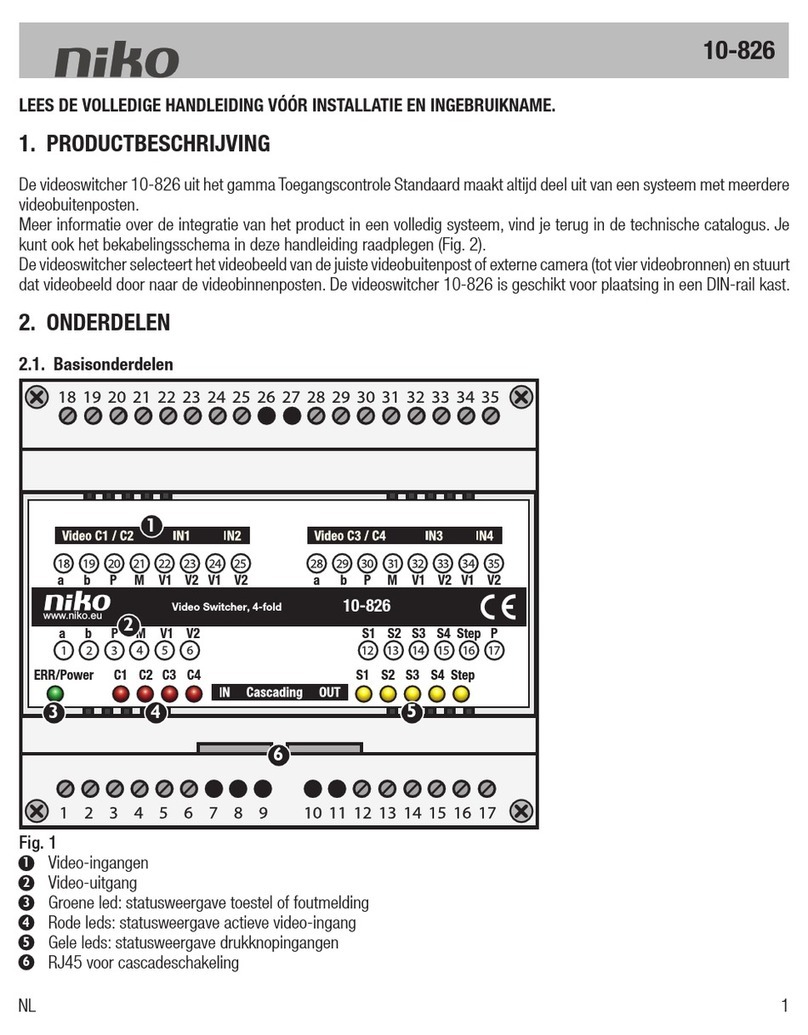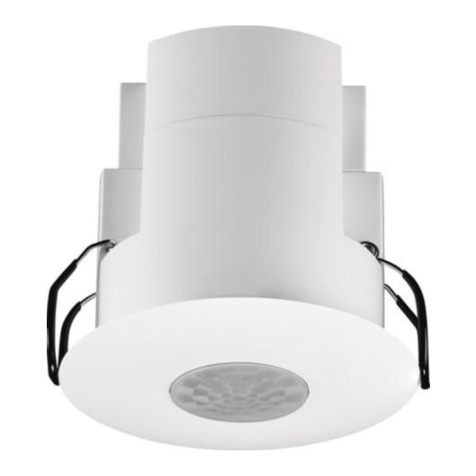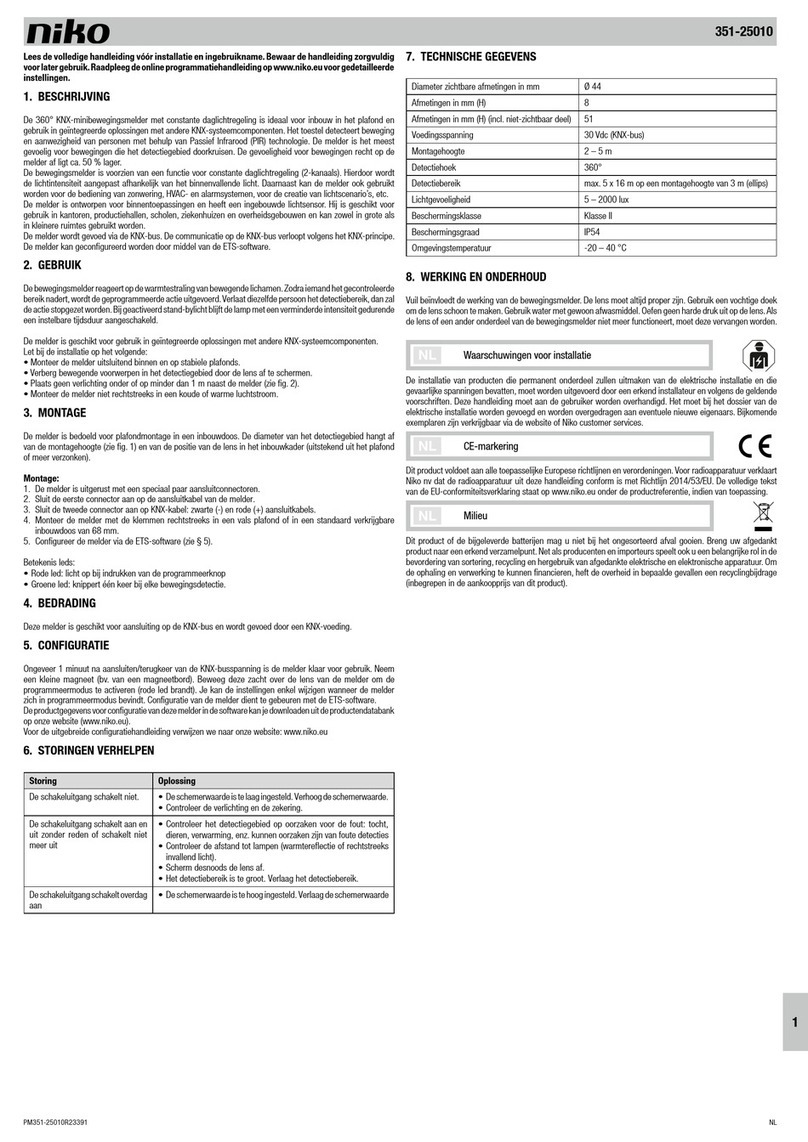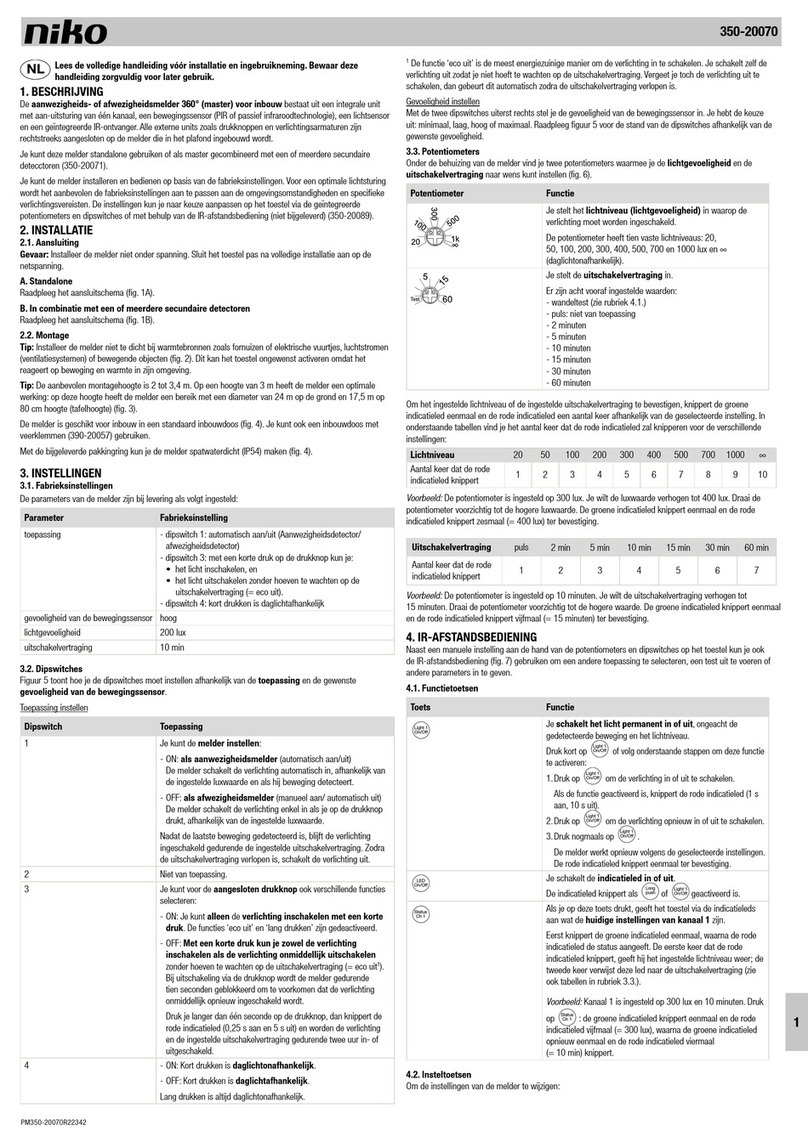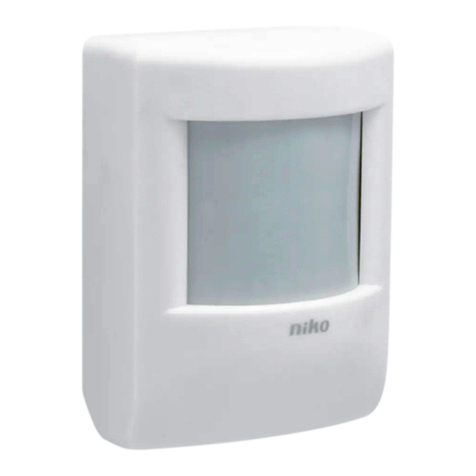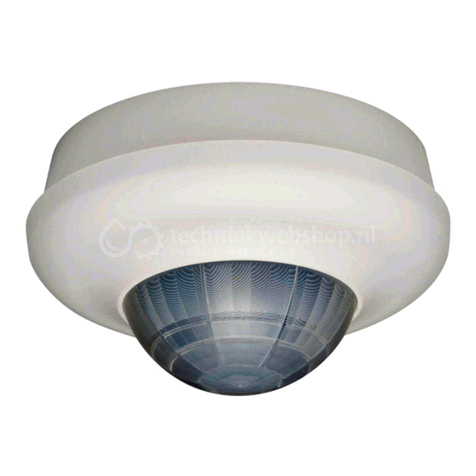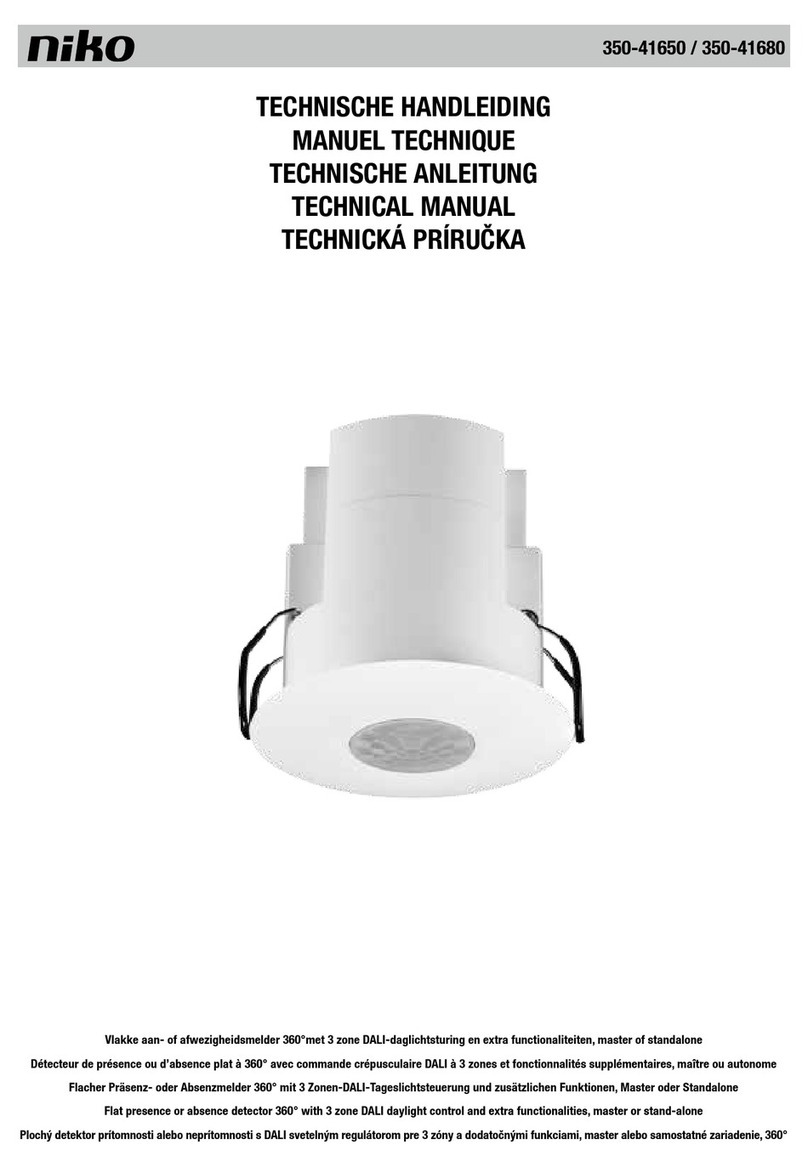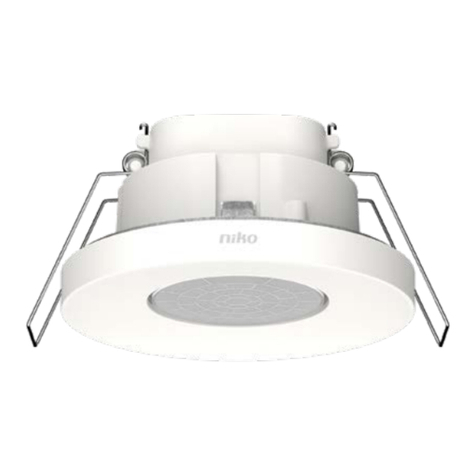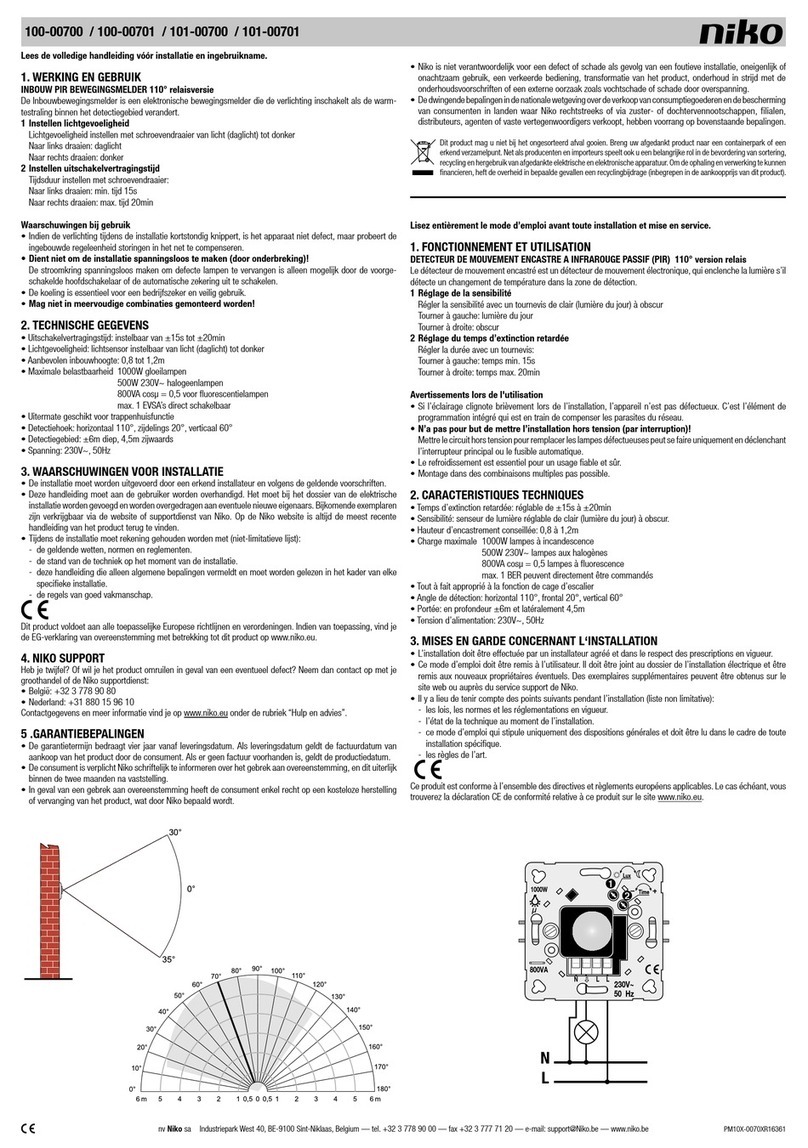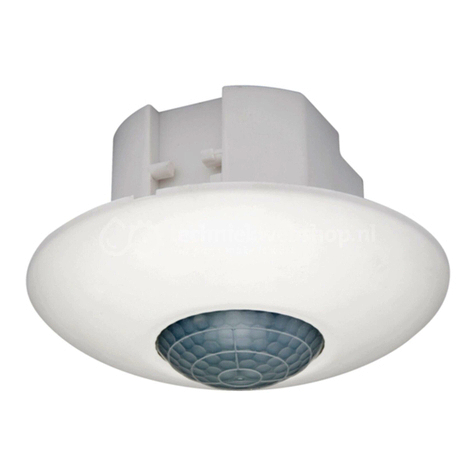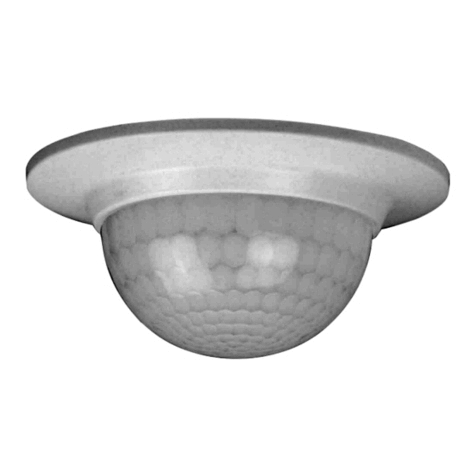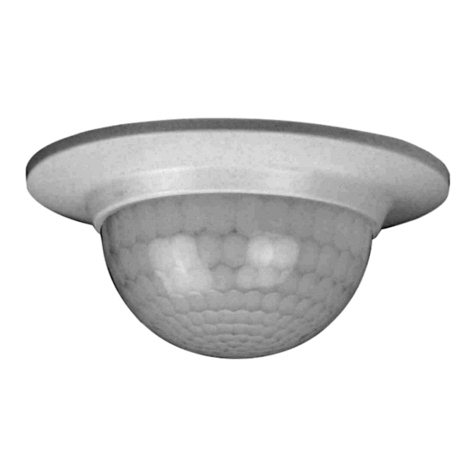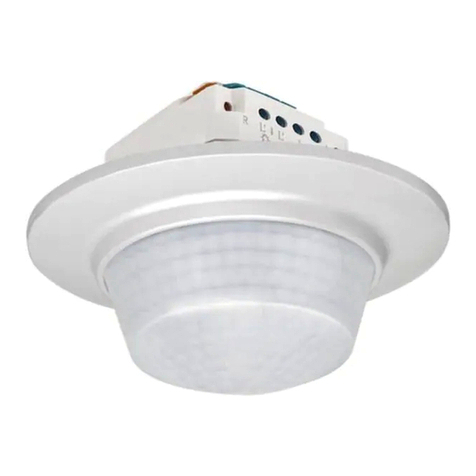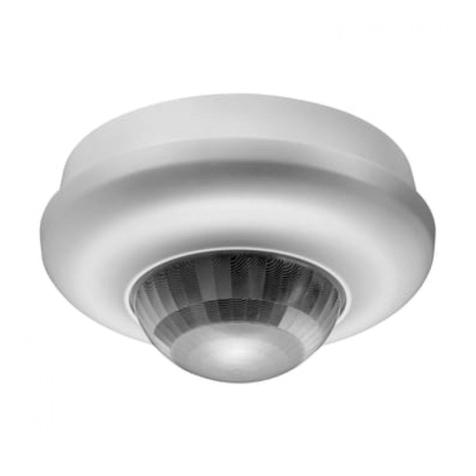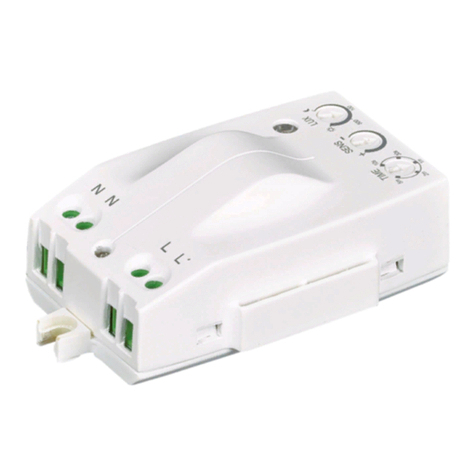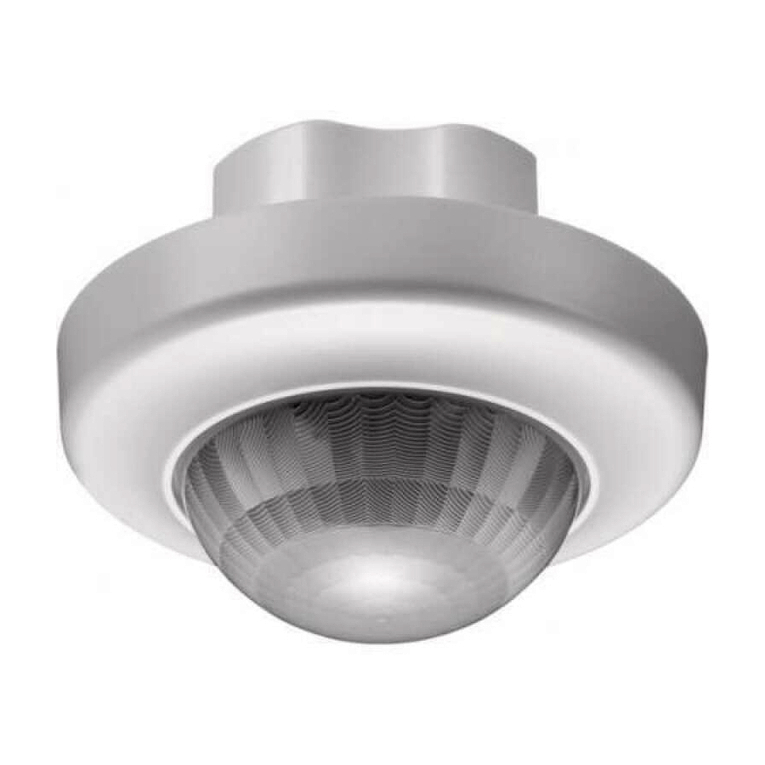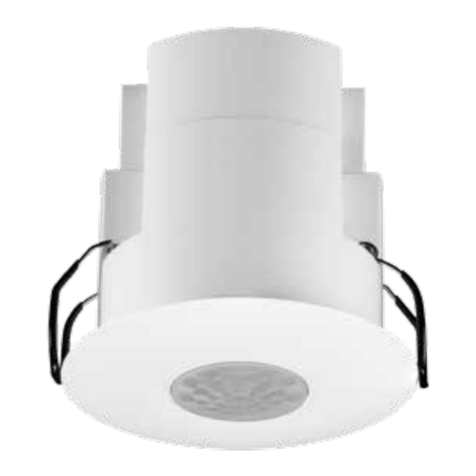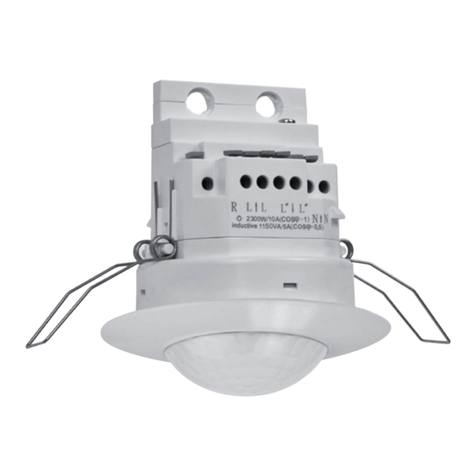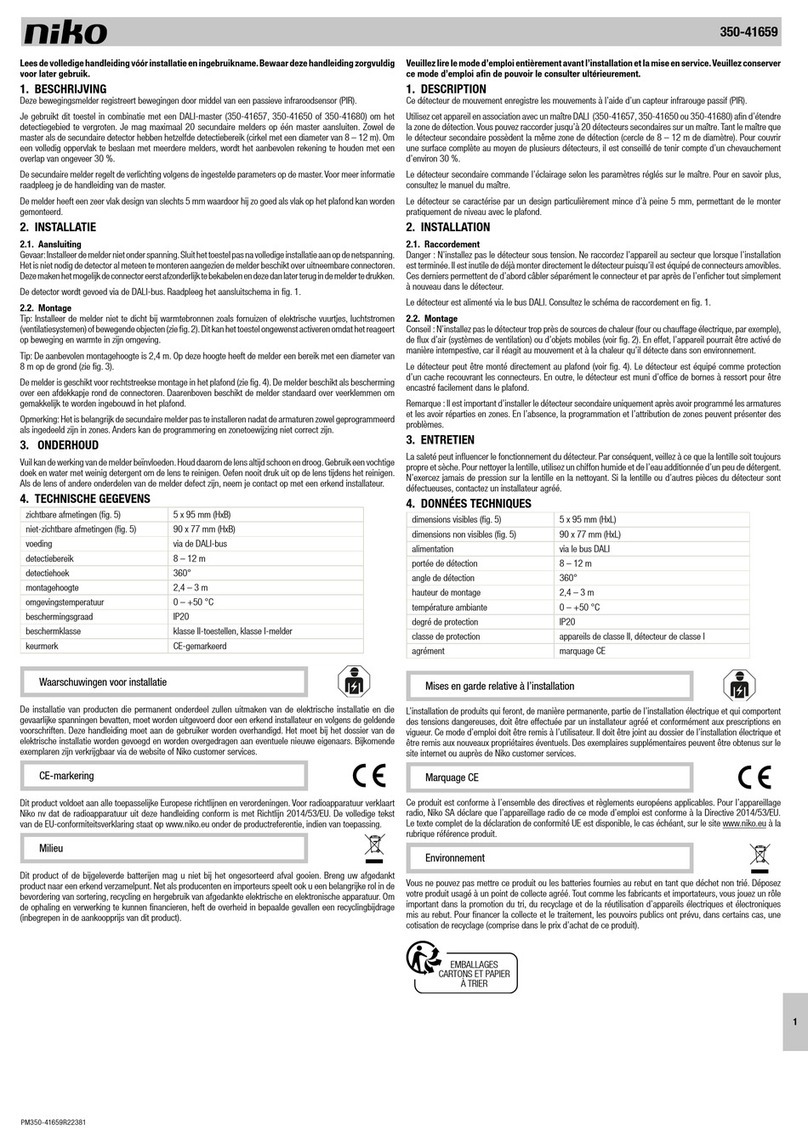
180°
R
A M
Presence detector, wall
Präsenzmelder, Wand
Détecteur de présence, mural
Rilevatore di presenza, parete
Czujnik obecności, naścienny
DE
FR
PL
IT
EN
Swiss Garde 300 Präsenz UP Max
Edition 09-2022
Art.-Nr. 25393, 25394, 25395CH, 25395D
2
71 34
5
6
L
L’
RN
7a
L
L’
R LL’ N
N
7b
2a 2b 2c
1a
1b
1c 3a
5a 5b 5c
5d
4a
4b
3b
max. 1000VA cos ϕ= 0,5
230V AC DC
HR * R *
1,0m 2 m 6m
1,5m 3 m 7m
2,0m 4 m 8m
2,5m 4 m 9m
3,0m 4 m 10m
R
1d
Edition
CH Edition PMI
Edition PMI
Edition
CH
Edition
EU
Edition
EU
DE Installationsanleitung
1. Produktbeschreibung
Der Melder erkennt Personenbewegungen und Personenanwesenheit mittels Passiv-Infrarot-Sensor (PIR).
Er reagiert am empfindlichsten bei Bewegungen, die tangential zum überwachten Bereich verlaufen (1a).
Bewegungen, die direkt auf den Melder erfolgen, haben eine reduzierte Empfindlichkeit von ca. -50% (1b).
Der Melder schaltet erst, wenn der eingestellte Helligkeitswert (Dämmerungsschwelle) unterschritten ist.
Die Schaltdauer wird verlängert, solange Personenbewegungen (gesamter Bereich 1d) detektiert werden.
Der Melder detektiert die Zunahme des Tageslichts nach dem Einschalten und schaltet bei genügen Tageslicht
automatisch aus. Produkte, die als Zubehör erwähnt werden, sind nicht im Lieferumfang enthalten.
2. Anwendung
Der Melder ist für den Innenbereich zur Steuerung von Leuchten geeignet.
Bei der Installation beachten:
– Nur für die Wandmontage geeignet.
– Bewegliche Gegenstände im überwachten Bereich durch Abkleben der Linse ausblenden.
– Keine Leuchten unterhalb oder weniger als 1m neben dem Melder platzieren (2a).
– Nicht in direkten Kälte- (2b) oder Wärmeluftstrom (2c) montieren.
3. Sicherheitshinweise
!
Vor der Installation prüfen, dass die elektrischen Leitungen spannungsfrei sind.
Die Installation darf nur durch Elektrofachpersonal unter Einhaltung der landesüblichen
Vorschriften erfolgen.
4. Montage (4)
Der Melder ist für eine Wandmontage von 1 bis 3 m Höhe vorgesehen.
Der Radius R des überwachten Bereichs ist abhängig von der Montagehöhe (1c).
Zur Montage:
– Schraubenzieher in die Aussparung (4a) setzen und nach vorne drücken.
– Schraube (4b) lösen und Linse entfernen.
– Melder gemäss Punkt 5 verdrahten.
– Melder in Unterputzdose befestigen.
– Konfiguration gemäss Punkt 7 durchführen.
– Linse aufsetzen und Schraube fixieren.
– Abdeckung aufsetzen und einrasten.
5. Verdrahtung (7)
Der Stromkreis muss mit einem Leistungsschutzschalter abgesichert sein. Der externe Taster schaltet den
stromführenden Leiter zum R-Eingang. Impulstaster ohne Glimmlampe verwenden und Leitungen kurz halten.
Stromführender Leiter L
Neutralleiter N
Schaltausgang Relais L’
Externer Taster (optional) R
6. Anschluss von Verbrauchern
Hohe Einschaltströme verkürzen die Lebendsauer des im Melder integrierten Relais. Beachten Sie die technischen
Angaben des Leuchten- bzw. Leuchtmittelherstellers, damit das Relais nicht überbelastet wird (3a–b). Um den
Schaltkreis übersichtlich zu halten, empfehlen wir, maximal 5 Melder parallel zu schalten. Bei überdurchschnittlich
häufigen Schaltzyklen oder bei erhöhten Lasten empfehlen wir, die Last über ein externes Relais / einen externen
Lastschutzschalter zu schalten. Beim Einsatz von Vorschaltgeräten empfehlen wir, die Anzahl auf 20 Stück pro Aus-
gang zu begrenzen.
7. Konfiguration
Der Melder ist ca. 1Minute nach dem Anschluss ans Stromnetz betriebsbereit. Parameteränderungen müssen im
Betrieb erfolgen: Die Parameter werden direkt an den Reglern am Melder oder über die Fernbedienung/App
(Zubehör) eingestellt. Instruktion kann aus der Gebrauchsanweisung der Fernbedienung entnommen werden.
ZEIT: Mit TIME wird die Nachlaufzeit nach der letzten Bewegung bestimmt (5b). Ist der Relaisausgang
auf einen Lichtautomaten verdrahtet, muss der TIME-Regler auf Impuls ( ) gesetzt werden.
Dämmerungsschwelle: Mit LUX wird die Ansprechschwelle des Dämmerungssensors stufenlos
zwischen Tagbetrieb und Nachtberieb eingestellt (5a).
Reichweite: Mit SENS wird die Reichweite eingestellt (5c). Ist der Melder zu empfindlich, so kann mit dieser
Einstellung die Sensibilität des Bewegungsmelders justiert werden.
8. Betriebswahltaste (5d)
(Nur aktiv wenn A-M Schalter auf M= Manuell steht) Folgende Funktionen können durch Drücken der Funktionswahl-
taste (in Abhängigkeit des ursprünglichen Betriebszustandes) gewählt werden:
Aktueller
Modus
Aktuell
Licht
Dauer des
Tastendrucks
Licht, nach
Tastendruck
Modus nach
Ablauf, Licht
Auto Aus 0.3 bis 5s Ein für 10min Auto, Aus
Auto Ein 0.3 bis 5s Aus für 10min Auto, Aus
beliebig beliebig 5 bis 10s Ein für 10h* Auto, Aus
beliebig beliebig > 10s Aus für 10h* Auto, Aus
*Ist der Melder im 10h Ein/Aus Modus, kann er durch Tastendruck von <1s in den Automatikmodus zurück gestellt
werden. Im Falle eines Stromunterbruchs, wird der Melder in den Automatikmodus zurückgestellt. Im Kurzimpuls-
Modus können diese Modi nicht aufgerufen werden.
9. Externer Taster
Der externe Taster ist optional. Das Licht kann manuell ein oder ausgeschaltet werden.
10. Anzeige
Die folgenden Zustände werden mittels LED angezeigt. Parameteränderungen können
an den Drehreglern oder über die Fernbedienung/App (Zubehör) erfolgen. Bei der Übernahme
einer Parameteränderung schaltet der Melder den Relaisausgang kurzzeitig aus.
Zustand Anzeige LED Dauer
Aufstarten ca. 1min, kurz blinken
Parameteränderung 3x kurz blinken
Bewegungsdetektion 1x lang blinken
11. Störungsbeseitigung
Verbraucher schaltet nicht: Schaltausgang schaltet zu häufig:
– Dämmerungsschwelle zu hoch – Reichweite reduzieren
– Leuchte/ Sicherung prüfen – Erfassungsbereich auf Fehlerquellen überprüfen
– Linse abkleben / Abstand zu Leuchten kontrollieren
– Dämmerungsschwelle zu niedrig
12. Technische Daten
Nennspannung 230V~ 50Hz
Schaltleistung Relais
max. 2000W, 8.7A (cos ϕ= 1,0)
max. 1000 VA, 4.35A (cos ϕ= 0,5)
LED 300W
Erfassungsbereich 180°
Reichweite ca. 10m Radius bei 3m Höhe
Dämmerungsregler 5–2000lx
Zeitregler Impuls ca. 10s bis 20min
Schutzart IP20
Temperaturbereich -20 bis +40°C
Montagehöhe 1–3m
Masse
CH: 88x88x35mm (Sichtmass)
EU: 80x80x32mm (Sichtmass)
PMI: 88x88x38mm (Sichtmass)
H = 1–1,5 m
❆
x
❄
❆
z
80 mm
32 mm 35 mm
80 mm
88 mm35 mm 35 mm
88 mm
48 mm
EN Installation instructions
1. Product description
The device detects the movements and presence of persons by means of a passive infrared (PIR) sensor.
It reacts most sensitively to movements which are tangential to the monitored area (1a).
Movements directly towards the detector result in a reduced sensitivity of approx. -50% (1b).
The detector does not switch until the brightness drops below the set value (twilight threshold).
The switching duration is extended as long as movements of persons (entire area 1d) are detected.
The detector detects an increase in daylight after switching on and, if there is sufficient daylight, switches off auto-
matically. Products which are indicated as accessories are not included in the scope of delivery.
2. Application
The detector is suitable for indoor use for lighting control.
Please observe the following during installation:
– Only suitable for wall installation.
– Mask moving objects in monitored area by taping over lens.
– Do not position any luminaires below or less than 1 m adjacent to detector (2a).
– Do not install in direct cold (2b) or warm air flows (2c).
3. Safety information
!
Before installation, check that the electric cables are not live.
Installation may only be performed by qualified electricians and
in accordance with the national regulations.
4. Installation (4)
The detector is intended for wall installation at a height of 1 to 3 m.
The radius (R) of the monitored area depends on the installation height (1c).
Installation details:
– Place screwdriver in opening (4a) and press in forward direction.
– Unscrew screw (4b) and remove lens.
– Wire detector as described under item 5.
– Fix detector in flush-mounting box.
– Configure device as described under item 7.
– Hold lens in place and screw down.
– Replace cover by snapping into place.
5. Wiring (7)
The electrical circuit must be protected by a circuit breaker. The external push-button switches the
line conductor to the R terminal. Use push-buttons without a glow lamp and keep wires short.
Line conductor L
Neutral conductor N
Relay switching output L’
External push-button
(optional) R
6. Connection of loads
High inrush currents shorten the service life of the relay integrated in the detector. Please observe the technical
specifications provided by the manufacturer of the lamps and lighting equipment to avoid overloading the relay
(3a–b).To keep circuits to a manageable size, we recommend connecting no more than 5 detectors in parallel. In case
of higher-than-normal switching cycle frequencies or loads, we recommend connection of the load via an external
relay / circuit breaker. Where electronic ballasts are used, we recommend that the number be limited to 20 per output.
7. Configuration
The detector is ready for operation approx. 1 minute after mains connection. Parameter changes must be made
during operation using either the control devices directly on the detector or the remote control
(accessory). For further details, please consult the operating instructions for the remote control.
TIME: TIME is used to set the delay after the last movement (5b). If the relay output
is wired to an automatic light, set TIME to impulse mode ( ).
Twilight threshold: LUX allows continuous setting of the trigger threshold of the twilight sensor
between day mode and night mode (5a).
Detection range: SENS is used to set the detection range (5c). This setting allows sensitivity to be adjusted if the
movement detector is oversensitive.
8. Function select button (5d)
(Only active if A-M switch is set to M = manual) The following functions can be selected by pressing the function select
button (depending on original operating status):
Present
mode
Light
status
Button hold-down
time
Light, after
pressing button
Mode after
expiry, light
Auto Off 0.3 to 5 s On for 10min Auto, off
Auto On 0.3 to 5 s Off for 10min Auto, off
Any Any 5 to 10 s On for 10h* Auto, off
Any Any > 10 s Off for 10h* Auto, off
*If the detector is in 10h on/off mode, it can be reset to automatic mode by pressing the push-button for <1s. Any
power failure will reset the detector to automatic mode. These modes are not available for selection in pulse mode.
9. External push-button
The external push-button is optional. The light can be switched on and off manually.
10. Display
The following statuses are indicated by the LED. Parameter changes can be made
using the rotary controls or the remote control/app (accessory). When a parameter change
is confirmed, the detector briefly switches off the relay output.
Status LED indication Duration
Start-up approx. 1min, short flashes
Parameter change 3 x short flashes
Movement detection 1 x long flash
11. Troubleshooting
Current-using equipment does not switch: Switching output switches too frequently:
– Twilight threshold too high – Reduce detection range
– Check luminaire / overcurrent protection – Check detection area for source of fault
– Tape over lens / Check distance from luminaires
– Twilight threshold too low
12. Technical data
Supply voltage 230V~ 50Hz
Relay switching power
max. 2000W, 8.7A (cos ϕ= 1.0)
max. 1000VA, 4.35A (cos ϕ= 0.5)
LED 300W
Detection angle 180°
Detection range Approx. 10m radius for 3m height
Lux level control 5–2000lx
Time control Impulse, approx. 10s to 20min
IP rating IP20
Temperature range -20 to +40°C
Installation height 1–3m
Dimensions
CH: 88x88x35mm (visible dimensions)
EU: 80x80x32mm (visible dimensions)
PMI: 88x88x38mm (visible dimensions)
FR Guide d’installation
1. Description du produit
Le détecteur identifie les mouvements et la présence de personnes par un capteur infrarouge passif (IR passif).
Sa sensibilité est optimale en cas de mouvements tangents par rapport à la zone surveillée (1a).
(1b).
Le détecteur se déclenche uniquement lorsque la luminosité est inférieure aux valeurs paramétrées (seuil crépuscu-
laire). La durée d’allumage est prolongée tant que des mouvements de personnes (toute la zone ) sont détectés.
Le détecteur note l’augmentation de la luminosité dès lors que l’éclairage est allumé et le coupe automatiquement
si la luminosité est suffisante. Les produits appartenant aux accessoires ne font pas partie du contenu de la livraison.
2. Application
Le détecteur convient pour la commande de l’éclairage en intérieur.
Pour l’installation, respecter les points suivants:
– Convient uniquement à un montage mural.
– Cacher les objets mobiles dans la zone surveillée en collant la lentille.
– Ne pas installer un éclairage sous le détecteur ou à une distance inférieure à 1m (2a).
– Ne pas monter directement dans des courants d’air froid (2b) ou chaud (2c).
3. Consignes de sécurité
!
Avant l’installation, vérifier que les câbles électriques sont hors tension.
L’installation peut uniquement être effectuée par un électricien spécialisé, dans le respect des
prescriptions nationales en vigueur.
4. Montage (4)
(1c).
Pour le montage:
– Insérer un tournevis dans le dégagement (4a) et pousser vers l’avant.
– Desserrer la vis (4b) et retirer la lentille.
– Câbler le détecteur selon le .
– Fixer le détecteur dans la boîte d’encastrement.
– Suivre la configuration selon le .
– Positionner la lentille et fixer la vis.
– Replacer le couvercle et enclencher.
5. Câblage (7)
Le circuit électrique doit être protégé par un disjoncteur de puissance. Le bouton poussoir externe commute la
phase sur l’entrée R. Utiliser un bouton poussoir à impulsions sans témoin lumineux et limiter la longueur du câblage.
Phase L
Neutre N
Sortie de commutation de relais L’
Bouton poussoir externe (en option) R
6. Raccordement d’appareils consommateurs
Des courants de démarrage élevés limitent la durée de vie du relais intégré au détecteur. Respecter les caractéris-
tiques techniques fournies par le fabricant d’ampoules et de luminaires, afin de ne pas surcharger le relais (3a–b).
Pour préserver la clarté du circuit de commutation, nous recommandons de limiter à 5 le nombre de détecteurs
raccordés en parallèle. Si la fréquence des cycles de commutation est supérieure à la moyenne ou en cas de charge
élevée, nous recommandons de raccorder la charge au travers d’un relais externe/d’un disjoncteur de charge externe.
Pour l’emploi de ballasts, nous recommandons de limiter leur nombre à 20 par sortie.
7. Configuration
Le détecteur est prêt à fonctionner env. 1 minute après son raccordement sur le secteur. Les modifications des
paramètres doivent être effectuées lorsque l’appareil est en fonctionnement: pour la configuration des paramètres, il
Les instructions d’utilisation sont consultables dans le mode d’emploi de la télécommande.
TEMPORISATION: TIME permet d’ajuster la durée d’allumage après le dernier mouvement détecté (5b). Si la sortie
de relais est raccordée à une minuterie d’éclairage, la fonction TIME doit être en mode Impulsion ( ).
Seuil crépusculaire: LUX permet d’ajuster en continu le seuil de réponse du capteur crépusculaire
entre le fonctionnement de journée et le fonctionnement de nuit (5a).
Portée: SENS permet de régler la portée de détection(5c). Si le détecteur est trop sensible, ce paramètre permet
d’ajuster la sensibilité du détecteur de mouvements.
8. Bouton de sélection du mode de fonctionnement (5d)
Les fonctions suivantes peuvent être actionnées en
enfonçant le bouton de sélection du mode de fonctionnement (en fonction du mode de fonctionnement d’origine):
Mode Actuel Éclairage Actuel Durée d’appui
du bouton
Éclairage, après
appui du bouton
Mode après
délai, éclairage
Auto Désactivé 0,3 à 5s Activé pendant 10min Auto, désactivé
Auto Activé 0,3 à 5s Désactivé pendant 10min Auto, désactivé
Libre Libre 5 à 10s Activé pendant 10h* Auto, désactivé
Libre Libre >10s Désactivé pendant 10h* Auto, désactivé
*Si le détecteur est en mode Activé ou désactivé pendant 10h, maintenir le bouton enfoncé pendant <1s permet de
retourner en mode automatique. Dans le cas d’une coupure de courant, le détecteur retourne en mode automatique.
En mode impulsion courte, ces modes sont inaccessibles.
9. Bouton poussoir externe
Le bouton poussoir externe est optionnel. L’éclairage peut être activé ou désactivé manuellement.
10. Affichage
Les états de fonctionnement suivants sont présentés à l’aide de voyants à LED. Les paramètres peuvent
les paramètres en compte, le détecteur coupe brièvement la sortie de relais.
État Affichage LED Durée
Démarrage
Modification des paramètres
Détection de mouvement
11. Dépannage
L’appareil ne se met pas en route: La sortie de commutation s’allume trop fréquemment:
– Seuil crépusculaire trop haut – Réduire la portée
– Contrôler la présence de sources d’erreur dans la zone de détection
– Coller lentille / Contrôler la distance aux ampoules
– Seuil crépusculaire trop bas
12. Caractéristiques techniques
Tension nominale 230V ~ 50Hz
Puissance de commutation du relais
max. 2000 ϕ
max. 1000 ϕ
LED 300W
Plage d’interception 180°
Portée env. 10m de rayon à une hauteur de 3m
Capteur crépusculaire 5–2000lx
Minuterie Impulsions, env. 10s jusqu’à 20min
Indice de protection IP20
Plage de température -20 à +40 °C
Hauteur de montage 1-3m
Dimensions
Suisse : 88x88x35mm (partie visible)
UE : 80x80x32mm (partie visible)
PMI: 88x88x38mm (partie visible)
IT Istruzioni per l'installazione
1. Descrizione del prodotto
Il dispositivo rileva i movimenti e la presenza di persone attraverso un sensore a infrarossi passivo (PIR).
La sensibilità massima si registra in presenza di movimenti tangenziali rispetto all’area monitorata (1a).
La sensibilità ai movimenti in direzione del rilevatore è ridotta di circa il 50% (1b).
Il rilevatore si attiva solo quando la luminosità è inferiore al valore impostato (soglia crepuscolare).
La durata di attivazione viene prolungata per il tempo in cui vengono rilevati movimenti di persone (intera area 1d).
Il rilevatore individua l'aumento della luce diurna dopo l'inserimento e, ove le condizioni di luminosità siano sufficien-
ti, si disinserisce automaticamente. I prodotti menzionati come accessori non sono compresi nel kit di base.
2. Impiego
Il rilevatore è progettato per la gestione delle luci in ambienti interni.
Osservazioni per l’installazione:
– montare solo a parete;
– nascondere gli oggetti mobili nell’area monitorata coprendo la parte di lente interessata con il nastro adesivo;
– non collocare alcuna luce sotto il rilevatore o a una distanza inferiore a 1m dallo stesso (2a);
– non esporre il rilevatore a flussi diretti di aria fredda (2b) o calda (2c).
3. Indicazioni sulla sicurezza
!
Prima dell’installazione verificare che i cavi elettrici siano privi di tensione.
L’installazione deve essere effettuata da elettricisti specializzati nel rispetto delle norme
nazionali.
4. Montaggio (4)
Il rilevatore è progettato per essere fissato a parete a un’altezza compresa tra 1 e 3 m.
Il raggio R dell’area monitorata dipende dall’altezza di montaggio (1c).
Per il montaggio:
– inserire il cacciavite nell'incavo (4a) e premere in avanti;
– allentare la vite (4b) e rimuovere la lente;
– cablare il rilevatore in base al punto 5;
– inserire il rilevatore nella scatola a muro;
– effettuare la configurazione in base al punto 7;
– posizionare la lente e serrare la vite;
– collocare il coperchio e fermarlo in sede.
5. Cablaggio (7)
Il circuito elettrico deve essere protetto con un interruttore magnetotermico. Il tasto esterno attiva il cavo sotto tensione
sull’ingresso R. Utilizzare il pulsante a impulso senza lampada al neon e mantenere i cavi corti.
Cavo sotto tensione L
Cavo neutro N
Uscita di commutazione relè L’
Tasto esterno (optional) R
6. Collegamento delle utenze
Correnti di attivazione elevate riducono la durata del relè integrato nel rilevatore. Per non sovraccaricare il relè, ri-
spettare le specifiche tecniche del produttore delle luci o delle lampade (3a–b). Per una chiara lettura del circuito di
commutazione, si consiglia di commutare in parallelo al massimo 5 rilevatori. In caso di cicli di accensione superiori
alla media o di carichi eccessivi, si raccomanda di commutare il carico tramite un relè/interruttore automatico esterno.
Se si utilizza il ballast, si consiglia di non superare 20 pezzi per uscita.
7. Configurazione
Il rilevatore può essere messo in funzione dopo circa 1 minuto dal collegamento alla rete elettrica. Le variazioni
ai parametri devono essere effettuate durante l'uso: i parametri vengono impostati direttamente sui regolatori del
rilevatore oppure attraverso il telecomando/app (accessorio). Le indicazioni possono essere desunte dalle istruzioni
per l'uso del telecomando.
Tempo: con TIME viene determinata la durata di funzionamento dall’ultimo movimento (5b). Se l’uscita relè
è cablata su un temporizzatore luce scale, il regolatore TIME deve essere impostato su «impulso» ( ).
Soglia crepuscolare: con LUX la soglia di risposta del sensore crepuscolare è regolabile in modo continuo
tra funzionamento diurno e funzionamento notturno (5a).
Campo di rilevamento: la portata viene regolata con SENS (5c). Con questa impostazione è possibile regolare la
sensibilità del rilevatore di movimento, qualora sia troppo elevata.
8. Pulsante selezione modalità operativa (5d)
(attivo solo quando l'interruttore A-M è su M= manuale) Le seguenti funzioni possono essere scelte premendo il
pulsante di selezione funzione (a seconda dello stato operativo originario):
Modalità
attuale
Luce
attuale
Durata
pressione
Luce dopo
pressione
Modalità al
termine, luce
Auto Spenta Da 0,3 a 5 sec Accesa per 10 min Auto, spenta
Auto Accesa Da 0,3 a 5 sec Spenta per 10min Auto, spenta
A piacere A piacere Da 5 a 10 sec Accesa per 10h* Auto, spenta
A piacere A piacere > 10 sec Spenta per 10 h* Auto, spenta
* se si trova in modalità On/Off 10h, il rilevatore può essere riportato in modalità automatica premendo il pulsante
per meno di 1 secondo. In caso di interruzione di corrente, il rilevatore viene riportato in modalità automatica. Nella
condizione «impulsi brevi» non è possibile attivare queste modalità
9. Pulsante esterno
Il pulsante esterno è opzionale. La luce può essere accesa o spenta manualmente.
10. Segnalazioni
Gli stati elencati in seguito vengono segnalati mediante LED. Le modifiche dei parametri possono essere effettuate
tramite manopole di regolazione oppure con telecomando/app (accessorio). A ogni modifica il rilevatore disattiva per
breve tempo l’uscita relè.
Stato Segnalazione LED Durata
Avvio ca. 1 min, lampeggio breve
Modifica parametri 3 lampeggi brevi
Rilevamento movimento 1 lampeggio lungo
11. Eliminazione dei guasti
L’utenza non si attiva: L’uscita di commutazione si attiva con una frequenza troppo alta:
– soglia crepuscolare troppo alta – ridurre il campo di rilevamento
– controllare luce / fusibile – verificare l’eventuale presenza di fonti di errore nel raggio di azione
– mascherare la lente / controllare la distanza dalle luci
– soglia crepuscolare troppo bassa
12. Dati tecnici
Tensione nominale 230V~ 50Hz
Potenza di apertura relè
max. 2000W, 8.7A (cos ϕ= 1,0)
max. 1000VA, 4.35A (cos ϕ= 0,5)
LED 300W
Raggio di azione 180°
Campo di rilevamento ca. 10m di raggio a un’altezza di 3m
Regolatore crepuscolare 5–2000lx
Timer Impulso da 10 s a 20min
Tipo di protezione IP20
Range di temperatura da -20 a +40°C
Altezza di montaggio 1-3m
Misure
CH: 88x88x35mm (parte visibile)
UE: 80x80x32mm (parte visibile)
PMI: 88x88x38mm (parte visibile)
PL Instrukcja instalacji
1. Opis produktu
Czujnik wykrywa ruchy ludzi i ich obecność w pomieszczeniu dzięki pasywnej czujce podczerwieni (PIR).
Czujnik jest najbardziej czuły na ruchy przebiegające po stycznej do monitorowanego obszaru (1a).
Ruchy przebiegające bezpośrednio w kierunku czujnika są wykrywane z czułością niższą o ok. -50% (1b).
Czujnik uruchomi się dopiero wtedy, gdy jasność będzie niższa od ustawionej wartości (próg zmierzchowy).
Czas przełączania jest wydłużany na okres, przez który jest wykrywany ruch ludzi (cały obszar 1d).
Po włączeniu czujnik wykryje wzrost natężenia oświetlenia światła dziennego i przy odpowiednim natężeniu tego
światła automatycznie się wyłączy. Produkty wymienione jako akcesoria nie są objęte zakresem dostawy.
2. Zastosowanie
Czujnik jest przeznaczony do sterowania oświetleniem wewnątrz pomieszczeń.
Podczas instalacji pamiętać, aby:
– stosować tylko do montażu naściennego.
– poprzez zaklejenie soczewki ukryć ruchome przedmioty w monitorowanym obszarze.
– nie umieszczać źródeł światła pod czujnikiem ani w odległości mniejszej niż 1 m od czujnika (2a).
– nie montować w miejscu bezpośrednio narażonym na strumień zimnego (2b) lub ciepłego powietrza (2c).
3. Wskazówki bezpieczeństwa
!
Przed rozpoczęciem instalacji upewnić się, że przewody elektryczne nie są pod napięciem.
Instalacji może dokonywać wyłącznie wykwalifikowany elektryk, przy przestrzeganiu obowiązu-
jących w danym kraju przepisów.
4. Montaż (4)
Czujnik przeznaczony jest do montażu naściennego na wysokości 1 do 3m.
Promień R monitorowanego obszaru zależy od wysokości montażu (1c).
Informacje na temat montażu:
– umieścić śrubokręt w rowku (4a) i docisnąć do przodu.
– poluzować śrubę (4b) i zdjąć soczewkę.
– wykonać okablowanie czujnika wg punktu 5.
– zamocować czujnik w puszce podtynkowej.
– przeprowadzić konfigurację wg punktu 7.
– nałożyć soczewkę i zamocować śrubę.
– nasadzić pokrywkę i wcisnąć ją w zatrzaski.
5. Okablowanie (7)
Obwód prądowy musi być zabezpieczony wyłącznikiem instalacyjnym. Przycisk zewnętrzny przełącza przewód pod
napięciem na wejście R. Zastosować przycisk impulsowy bez lampki neonowej, przewody powinny być krótkie.
Przewód pod napięciem L
Przewód zerowy N
Wyjście załączające przekaźnika L’
Przycisk zewnętrzny (opcjonalnie) R
6. Podłączenie odbiorników
Wysokie prądy załączeniowe skracają żywotność przekaźnika zintegrowanego w czujniku. Przestrzegać danych tech-
nicznych producenta lamp i urządzeń oświetleniowych, aby nie dopuścić do przeciążenia przekaźnika (3a–b). W celu
zapewnienia przejrzystości układu przełączającego, zalecamy równoległe łączenie maks. 5 czujników. W przypadku
zwiększonej liczby cykli łączeniowych lub większych obciążeń, zalecamy załączanie obciążenia za pomocą zewnętrz-
nego przekaźnika / zewnętrznego wyłącznika ochronnego. W przypadku stosowania stateczników zalecamy ograni-
czenie ich liczby do 20 sztuk na wyjście.
7. Konfiguracja
Po upływie ok. 1 minuty od momentu podłączenia do prądu czujnik jest gotowy do pracy. Zmiany parametrów doko-
nywane są w czasie pracy: Parametry należy ustawić bezpośrednio na regulatorach czujnika lub za pomocą pilota
zdalnego sterowania/aplikacji (akcesoria). Instrukcja znajduje się w instrukcji stosowania pilota.
CZAS: Funkcja TIME służy do określania czasu opóźnienia liczonego od ostatniego ruchu (5b). Jeśli wyjście przekaź-
nika jest połączone z automatycznym wyłącznikiem światła, należy ustawić regulator TIME na impuls ( ).
Próg zmierzchowy: Funkcja LUX umożliwia bezstopniową regulację progu załączenia czujnika zmierzchowego
między trybem dziennym a trybem nocnym (5a).
Zakres detekcji: Funkcja SENS umożliwia regulację zakresu detekcji (5c). Jeśli czujnik jest zbyt czuły, to w tym
ustawieniu można wyregulować czułość czujnika ruchu.
8. Przycisk wyboru trybu pracy (5d)
(Aktywny tylko w przypadku, gdy przełącznikA-M znajduje się na M= ręcznie) Poniższe funkcje można wybrać poprzez
naciśnięcie przycisku wyboru funkcji (zależnie od wyjściowego stanu pracy):
Aktualny
tryb
Aktualne
światło
Czas trwania
naciśnięcia przycisku
Światło, po
naciśnięciu przycisku
Tryb po
upływie czasu, światło
Auto Wył. 0,3 do 5 sek. Wł. przez 10min Auto, wył.
Auto Wł. 0,3 do 5 sek. Wył. przez 10min Auto, wył.
Dowolny Dowolny 5 do 10 sek. Wł. przez 10h* Auto, wył.
Dowolny Dowolny > 10 sek. Wył. przez 10h* Auto, wył.
*Jeśli czujnik znajduje się w 10h trybie WŁ./WYŁ., naciśnięcie przycisku przez <1s spowoduje powrót do trybu
automatycznego. W przypadku przerwy w dopływie prądu czujnik powróci do trybu automatycznego. W trybie
krótkoimpulsowym nie da się uruchomić tych trybów.
9. Przycisk zewnętrzny
Przycisk zewnętrzny jest opcjonalny. Możliwe jest ręczne włączanie lub wyłączanie światła.
10. Wyświetlanie
Poniższe stany wyświetlane są za pomocą diod LED. Parametry można zmieniać za pomocą pokręteł lub pilota
zdalnego sterowania/aplikacji (akcesoria). Przy przejmowaniu zmiany parametru czujnik na krótko wyłączy wyjście
przekaźnika.
Stan Wskazanie LED Czas trwania
Uruchomienie ok. 1min., krótkie miganie
Zmiana parametrów 3x krótkie miganie
Detekcja ruchu 1x długie miganie
11. Usuwanie zakłóceń
Odbiornik nie przełącza się: Wyjście załączające uruchamia się zbyt często:
– zbyt wysoki próg zmierzchowy – zmniejszyć zakres detekcji
– sprawdzić lampę /bezpiecznik – sprawdzić obszar detekcji pod kątem źródeł błędów
– zakleić soczewkę / sprawdzić odległość od opraw
– zbyt niski próg zmierzchowy
12. Dane techniczne
Napięcie znamionowe 230V ~ 50Hz
Moc załączania
przekaźnika
maks. 2000W, 8.7A (cos ϕ= 1,0)
maks. 1000VA, 4.35A (cos ϕ= 0,5)
LED 300W
Obszar detekcji 180°
Zakres detekcji promień ok 10m przy wysokości 3m
Regulator zmierzchowy 5–2000lx
Regulator czasowy Impuls ok. 10 s do 20min
Stopień ochrony IP20
Zakres temperatur -20 do +40°C
Wysokość montażu 1–3m
Wymiary
CH: 88x88x35mm (wymiar widoczny)
EU: 80x80x32mm (wymiar widoczny)
PMI: 88x88x38mm (wymiar widoczny)
L
N
L
N
Supply voltage 230V ~50Hz
Circuit breaker maximum MCB rating 10 A*
Relay switching power
max. 2000 W, 8.7 A (cos ϕ = 1.0)
max. 1150VA, 4.35 A (cos ϕ = 0.5)
LED 300W
Detection angle 180°
Detection range Approx. 10 m radius for 3 m height
Lux level control 5–2000lx
Time control Impulse approx. 10s to 20min
IP rating IP20
Temperature range -20 to +40 °C
Installation height 1–3m
Dimensions
CH: 88x88x35 mm (visible dimensions)
EU: 80x80x32 mm (visible dimensions)
PMI: 88x88x38 mm (visible dimensions)
* The MCB rating is limited by national installation rules.
Nennspannung 230V ~50Hz
Leistungsschalter maximaler MCB-Wert 10 A*
Schaltleistung Relais
max. 2000 W, 8.7 A (cos ϕ = 1.0)
max. 1150VA, 4.35 A (cos ϕ = 0.5)
LED 300W
Erfassungsbereich 180°
Reichweite ca. 10 m Radius bei 3 m Höhe
Dämmerungsregler 5–2000lx
Zeiteinstellung Impuls ca. 10s bis 20 min
Schutzart IP20
Temperaturbereich -20 bis +40°C
Montagehöhe 1–3m
Masse
CH: 88x88x35mm (Sichtmass)
EU: 80x80x32mm (Sichtmass)
PMI: 88x88x38mm (Sichtmass)
* Der MCB-Wert ist durch nationale Installationsvorschriften begrenzt.
Tension nominale 230V ~50Hz
Disjoncteur calibre maximum du disjoncteur miniature 10 A*
Puissance de coupure du relais
max. 2000 W, 8.7 A (cos ϕ = 1.0)
max. 1150VA, 4.35 A (cos ϕ = 0.5)
LED 300W
Zone de détection 180°
Portée env. 10 m de rayon à une hauteur de 3 m
Réglage crépusculaire 5-2000lx
Temporisation Impulsion env. 10secà 20min
Type de protection IP20
Plage de températures -20 à +40 °C
Hauteur de montage 1 à 3 m
Dimensions
CH: 88x88x35mm (partie visible)
EU: 80x80x32mm (partie visible)
PMI: 88x88x38mm (partie visible)
* Le calibre du disjoncteur miniature est limité par les règles nationales en matière d’installation.
Tensione nominale 230V ~50Hz
Interruttore di circuito valore massimo MCB 10 A*
Potenza commutabile relè
max. 2000 W, 8.7 A (cos ϕ = 1.0)
max. 1150VA, 4.35 A (cos ϕ = 0.5)
LED 300W
Raggio di azione 180°
Campo di rilevazione ca. 10 m di raggio a un’altezza di 3 m
Regolatore crepuscolare 5–2000 lx
Regolazione del tempo Impulso ca. da 10s a 20min
Tipo di protezione IP20
Range di temperatura da -20 a +40°C
Altezza di montaggio 1–3m
Dimensioni
CH: 88x88x35mm (parte visibile)
EU: 80x80x32mm (parte visibile)
PMI: 88x88x38mm (parte visibile)
* Il valore dell’interruttore magnetotermico è limitato dalle norme di installazione nazionali.
Napięcie znamionowe 230V ~50Hz
Wyłącznik obwodu maksymalna wartość znamionowa MCB 10 A*
Moc załączania przekaźnika
max. 2000 W, 8.7 A (cos ϕ = 1.0)
max. 1150VA, 4.35 A (cos ϕ = 0.5)
LED 300W
Obszar detekcji 180°
Zasięg promień ok 10 m przy wysokości 3 m
Regulator zmierzchowy 5–1000lx
Ustawienie czasu Impuls ok. 10 s do 20min
Stopień ochrony IP20
Zakres temperatur -20 do +40°C
Wysokość montażu 1–3m
Wymiary
CH: 88x88x35mm (wymiar widoczny)
EU: 80x80x32mm (wymiar widoczny)
PMI: 88x88x38mm (wymiar widoczny)
* Wartość MCB jest ograniczona przez krajowe przepisy dotyczące instalacji.
This product must be secured with a miniature circuit breaker (MCB) of max. 10 A in the electrical cabinet.
The MCB rating is limited by national installation rules.
